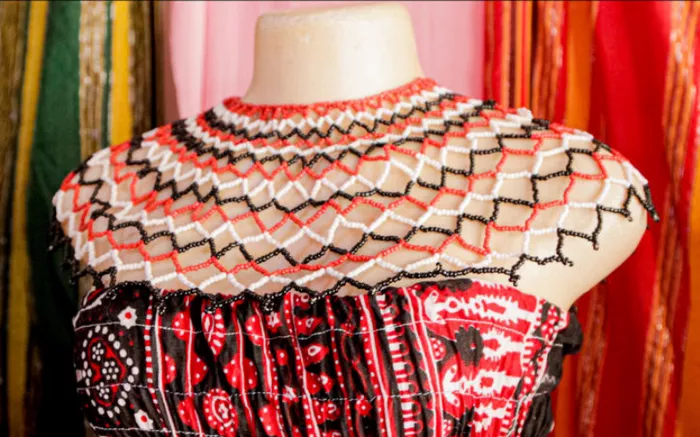The Mijikenda’s hando dress, once a powerful symbol of cultural identity worn during sacred ceremonies, community gatherings, and rituals, is seeing a resurgence thanks to the vision of one woman. For generations, elders, spiritual leaders, and traditional healers wore the hando as part of ancestral veneration rites, while women donned it as a dress and men as a shawl or waist garment.
However, as Western fashion trends gained traction and factory-made fabrics became more accessible, the use of the hando began to fade. Younger generations gravitated toward modern attire, and the traditional craft that had been passed down through generations was at risk of disappearing.
But in Kilifi County, a young designer is determined to change that. Edna Dhahabu, a 28-year-old from Rabai, has taken it upon herself to breathe new life into the hando by blending traditional craftsmanship with contemporary fashion, gaining recognition both locally and internationally.
“Hando was once considered attire for the Kaya elders, and young people viewed it as outdated. Over time, the fabric started to vanish, and the weaving skills were left with the elders, who are passing away,” says Dhahabu.
With meticulous care, Dhahabu weaves vibrant fibers into the intricate patterns of hando. For her, weaving is not just a craft—it is a legacy passed down from her grandmother. “My grandmother taught me how to weave the hando. She would spend hours creating beautiful patterns while telling stories about our ancestors. I saw an opportunity to preserve our culture and make a living,” she recalls.
Recognizing the decline of the hando, Dhahabu set out to modernize the traditional garment without compromising its authenticity. By experimenting with innovative cuts, bold color palettes, and contemporary embellishments, she made the hando appealing to both young people and the global market. “I added beads, seashells, and white cowrie shells to retain the coastal touch,” she explains.
Her bold approach has proven successful. Once reserved for local ceremonies, her modernized hando designs have now made their way into urban fashion circles and have been featured in fashion shows across Nairobi, Mombasa, Dubai, and the United States.
“Last year, I secured a tender to produce 150 handos for a Sudanese wedding at Sh20,000 each, and the fabric was shipped to South Sudan. This is a testament to the global interest in the hando,” Dhahabu shares. “I also have clients in Dubai and the United States.”
A complete hando set now sells for Sh15,000, and during peak seasons, her business generates up to Sh300,000. Dhahabu’s designs, which incorporate influences from both Western and Southern African fashion, have gained a following beyond the coastal region. Major fashion retailers in Nairobi and Mombasa now carry her pieces, while international buyers appreciate the cultural fusion her work represents.
Dhahabu’s journey began in 2019 with a modest Sh20,000 in savings. Since then, she has built a thriving business that now employs 17 full-time youth staff and has trained dozens of young artisans in the craft of hand weaving.
“I work closely with Kaya elders who hold the skill of hando weaving. In addition to providing them with business, they help train the youth, preserving the art and passing the knowledge to the younger generation,” she says.
Beyond her success, Dhahabu is passionate about empowering young people in Kilifi County, where unemployment is a significant challenge. Through structured training programs, she offers an alternative livelihood to young artisans and helps them develop their skills.
One of Dhahabu’s trainees, Zawadi Chengo, is a young woman who once struggled to find stable employment. “I never thought I could turn this skill into a career. Through the training, I now create various fashion items, from bangles to clothing fabric. If this expanded, it could provide more employment opportunities for talented youth while conserving our heritage,” Chengo says.
With a newly opened second workshop in Rabai Sub-county, Dhahabu has grown her team to 11 full-time employees and offers mentorship to 15 trainees on a demand basis. Her business model ensures that young artisans not only learn the craft but also gain an understanding of the business side of the fashion industry.
“Fashion is not just about creativity; it’s also about sustainability and economic empowerment,” Dhahabu emphasizes. “I want young people to realize that our traditions are not outdated relics but valuable assets that can generate wealth and global recognition.”
Dhahabu’s story reflects a broader trend in Kenya, where small and medium-sized enterprises (SMEs) are driving job creation and economic growth, making her journey a testament to the power of culture, tradition, and entrepreneurship.
Related Topics
- Shein Removes Products After Alleged Intellectual Property Theft from NZ Designer Sera Lilly
- Tyla Stuns on the Red Carpet at the 2025 Billboard Women in Music Awards
- POP Partners with Samantha Prabhu’s Fashion Brand Saaki, Targets $25M GMV by Year-End

